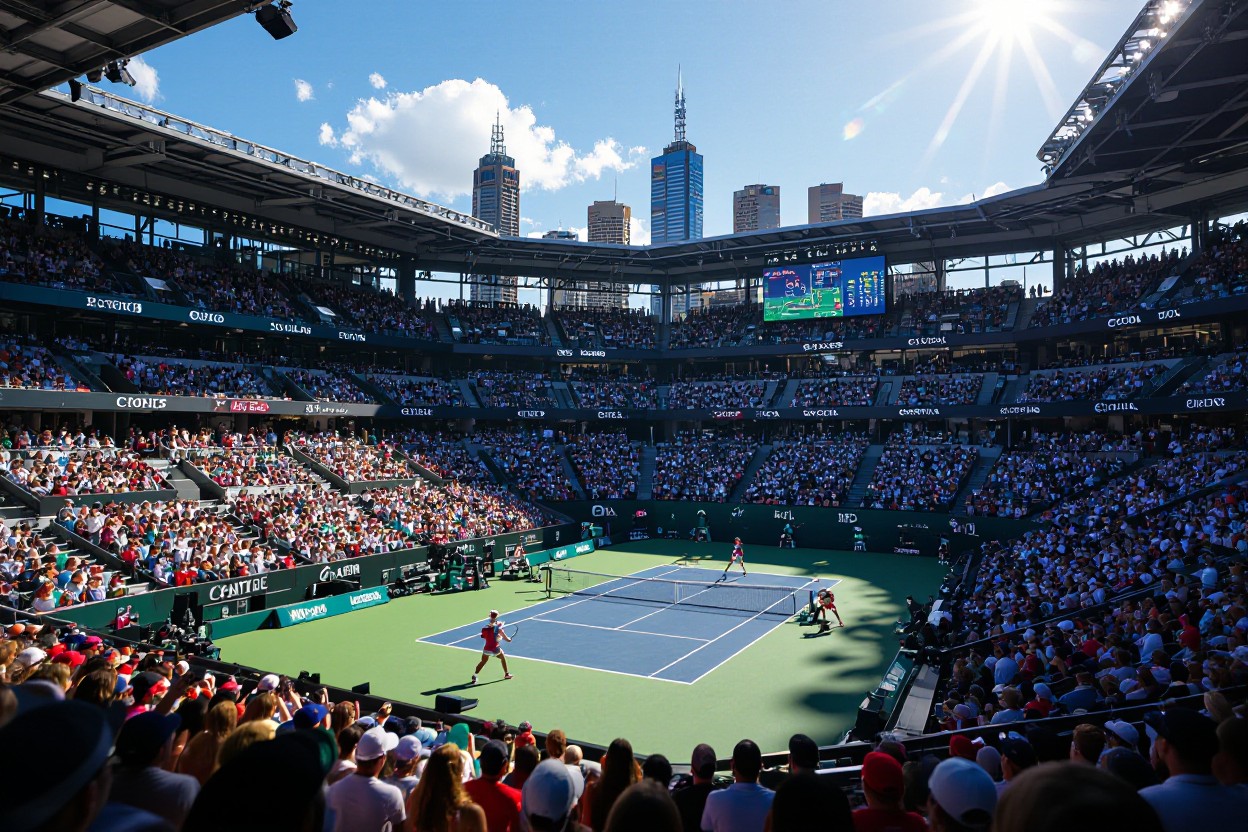Australian tennis enthusiasts like you witness firsthand how the Australian Open has transformed the global tennis calendar. As the year’s first Grand Slam, it sets the tone for players and fans worldwide, influencing training schedules and tournament planning. You’ll find that its unique timing in January forces players to adapt quickly after the off-season, impacting performance and strategy throughout the year. This event’s position has also driven the development of warm-up tournaments and shifted the focus of tennis markets globally, ensuring that your tennis calendar stays dynamic and exciting from the very start.
The Historical Significance of the Australian Open
The Australian Open’s rich history has firmly established it as a key pillar in the tennis world. Since its inception, the tournament has evolved tremendously, influencing tennis styles, player preparation, and the international calendar. By consistently adapting—introducing innovations like night matches and the Hawk-Eye system—it has enhanced player performance and fan engagement. Your appreciation of the Open grows as you recognize its role in shaping the competitive landscape and inspiring athletes worldwide, turning it from a regional contest into a global tennis beacon.
From Mildura to a Global Phenomenon
The Australian Open began modestly in 1905 in the town of Mildura, Victoria, drawing a small but passionate local crowd. Over the decades, it moved cities and improved facilities, culminating in its 1988 relocation to Melbourne Park, which expanded capacity and visibility. This transformation attracted international stars and boosted media coverage, turning it into one of the sport’s four Grand Slams. As you follow the tournament today, you experience the culmination of more than a century’s evolution from humble beginnings to global prominence.
Milestone Matches that Shaped Tennis
Several iconic matches at the Australian Open have left an indelible mark on tennis history, showcasing moments of resilience, rivalry, and breakthrough. The 1980 final where Björn Borg narrowly defeated Kim Warwick, demonstrated endurance under extreme heat, while the 2012 marathon between Novak Djokovic and Rafael Nadal redefined physical limits. Witnessing these matches imparts a deeper respect for how they influence playing styles, training methods, and even tournament scheduling across the tennis calendar.
Beyond their immediate excitement, these milestone matches have each contributed lasting legacies. For example, Djokovic and Nadal’s 2012 clash, lasting nearly six hours, highlighted the need for improved player recovery protocols and influenced how tournaments structure rest days. Matches like these have also spurred innovations such as the introduction of heat policies and expanded medical support, directly impacting how you see players manage the grueling demands of Grand Slam tennis today.
The Australian Open’s Role in Shifting Global Priorities
By anchoring the tennis season with a January Grand Slam, the Australian Open effectively resets players’ annual goals and training schedules worldwide. This early highlight compels professionals to peak sooner, influencing their offseason conditioning and tournament selections in the preceding months. The event’s prestigious status and substantial prize pool have nudged organizers and players across continents to recalibrate their calendars, balancing preparation with global travel demands. Your experience as a tennis fan is enriched as this recalibration offers a new narrative arc, spotlighting the Australian Open as not just a season opener but a defining pillar shaping global tennis strategy.
Location and Timing: A Long-Term Strategy
Positioned in Melbourne during the height of the Southern Hemisphere summer, the Australian Open capitalizes on optimal weather and time zone advantages to attract worldwide viewership. This timing allows players to recover post-holiday break and engage in preliminary warm-up events localized in Oceania and Asia. The selection of Melbourne as a consistent host city secures a stable base, facilitating logistical ease and fan travel planning. This location and timing synergy invites you to witness elite tennis against a vibrant cultural backdrop early in the year, reinforcing the event’s global prominence and appeal.
Elevating Player Engagement and Sponsorship Opportunities
The Australian Open’s strategic enhancements, including night matches and player lounges, boost athlete visibility and comfort, encouraging participation of top-tier talent. Its innovative use of technology for fan interaction and broad broadcasting rights has expanded sponsor interest, leading to increased investment from brands worldwide. For you, this means access to higher-quality matches featuring the sport’s elite and enriched viewing experiences that align with modern entertainment trends.
Expanding on this, the integration of cutting-edge facilities like the Rod Laver Arena’s retractable roof and advanced player recovery zones exemplifies how the Australian Open prioritizes athlete well-being and performance. Sponsors such as Kia Motors and Emirates Airlines have leveraged these advancements to activate global marketing campaigns, aligning their brands with the tournament’s prestige and innovation. Your engagement is amplified through digital platforms offering personalized content, while players benefit from enhanced exposure and lucrative endorsements, all driving the event’s elevated global status.
Reimagining the Off-Season: The Impact on ATP and WTA Calendars
Adjustments to the Australian Open have led both ATP and WTA to rethink the traditional off-season, which now features shorter breaks and rescheduled preparatory tournaments. You’ll notice that players often transition more rapidly from rest into competition, with events like the ATP Cup and WTA Brisbane International filling gaps to optimize peak performance ahead of the first Grand Slam. These shifts have compressed the calendar, increasing player workload but also offering more competitive opportunities during what was previously downtime.
New Event Dynamics Post-Tournament
Following the Australian Open, tour organizers have introduced events that capitalize on players’ early-season momentum. Tournaments such as the Great Ocean Road Open emerged as innovative platforms, offering localized competition that reduces travel strain. For you, this means witnessing players maintain form and engage with diverse venues immediately after a Grand Slam, increasing both variety and intensity within the early-year tennis schedule.
Balancing Events: Risks and Opportunities
The drive to balance player fatigue with fan engagement has led to tighter scheduling, which creates a double-edged sword scenario. While more tournaments generate excitement and exposure, you should consider how intensified competition can elevate injury risks. Streamlining events without overcrowding the calendar becomes a strategic necessity to sustain athlete health and maintain high-level play throughout the season.
Delving deeper into this balance, the ATP and WTA face constant pressure to fill the calendar with engaging contests while preventing burnout. Players like Rafael Nadal and Ashleigh Barty have openly discussed challenges posed by back-to-back events. As a tennis follower, understanding this tension helps you appreciate the nuanced decisions behind tournament placements and player schedules, where organizers juggle maximizing global reach with ensuring athletes’ longevity, keeping the sport vibrant and competitive year-round.
Cultural and Economic Ramifications of an Evolving Calendar
The shifting Australian Open schedule has ripple effects beyond the courts, redefining cultural connections and economic landscapes. You’ll notice how timing changes influence fan engagement globally, reshaping tradition and broadening tennis’s appeal. The tournament’s pacing affects player participation and media rights, altering how tennis integrates into various cultural calendars. This evolution intertwines local enthusiasm with international expectations, highlighting the sport’s adaptability and its role in global sporting culture.
National Identity and International Audience
The Australian Open serves as a platform where Australia showcases its sporting culture while engaging an international audience. You experience a blend of local pride and global viewership, with the event promoting Australian hospitality and innovation. The tournament’s expanded global reach helps position Australia not just as a sport destination, but as a symbol of tennis’s inclusiveness and diversity, connecting varied cultures through shared passion.
Financial Gains: Tourism and Local Economies
Hosting the Australian Open attracts over half a million visitors annually, injecting around AU$350 million directly into Melbourne’s economy. You benefit as this influx boosts local businesses from hospitality to retail, creating thousands of jobs and sustaining sports-related industries year-round. The event also drives long-term tourism by positioning Melbourne as a vibrant, world-class city.
Delving deeper, the tournament’s timing shifts can strategically extend its economic impact. For example, scheduling changes that avoid clashes with other major events increase tourist stay duration and spending. Melbourne’s coordinated campaigns during the Open integrate adjacent cultural festivals and exhibitions, maximizing visitor engagement. Investments in infrastructure, such as transport and venues, not only support the event but enhance the city’s capacity to attract future international conferences and sporting events, multiplying financial benefits across sectors.
Future Prospects: Predicting Changes in Professional Tennis
The Australian Open’s innovative scheduling and adaptability signal a shift toward more dynamic global tennis calendars. Expect more tournaments to adjust dates and formats in response to player feedback and fan engagement, increasing the sport’s accessibility worldwide. Players might benefit from reduced travel demands, while fans gain more uninterrupted access to high-stakes matches. With climate-related concerns, you’ll likely see tournament organizers experimenting with indoor events or flexible timing, which will continue to redefine what the tennis season looks like on a global scale.
The Role of Technology and Media in Tennis Evolving Schedules
Advancements in live streaming, AI-driven analytics, and virtual reality are transforming how tennis matches reach you and influence scheduling decisions. Real-time data allows organizers to optimize match times for maximum viewership across multiple time zones, enhancing your experience. Social media buzz and instant highlights create global demand that shapes tournament timelines. These technologies also help predict and reduce player fatigue, leading to smarter scheduling that balances performance and entertainment.
Keeping Up with Global Trends: Adapting to Change
International tennis events are increasingly aligning themselves with the global sports ecosystem by embracing cultural and seasonal differences, ensuring you enjoy tennis year-round without extreme weather interruptions. Integration with regional tournaments and local fan preferences means the calendar might shift more frequently, reflecting real-world circumstances and keeping tennis relevant across continents.
Local adaptations, like incorporating Asian swing tournaments earlier due to booming tennis markets in China and Japan, or shifting the South American clay season to avoid peak summer heat, are real examples of tennis adapting to your global interests. The sport’s growth in emerging regions pressures organizers to integrate new venues and audiences strategically, maintaining competitive balance while fostering inclusivity. This approach underlines a future where tennis not only follows tradition but thrives through constant evolution tailored to diverse global fanbases.
Summing up
Drawing together the significant shifts brought by the Australian Open, you can see how it reshaped the global tennis calendar. Its early-year placement energizes the season, setting a competitive tone and influencing players’ preparation strategies worldwide. The event’s innovations and scheduling have prompted other tournaments to adapt, ensuring a more dynamic and balanced tour. This evolution means your engagement with tennis is richer, as the Australian Open not only challenges athletes but also enhances the sport’s global rhythm and appeal throughout the year.




